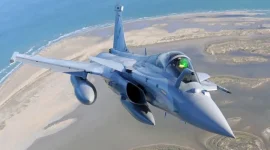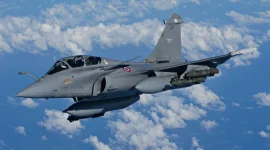- Views: 832
- Replies: 10

The Indian Navy's recent agreement to acquire 26 Rafale M fighters from France is a significant step not only in strengthening its naval air fleet but also in providing a valuable blueprint for the development of indigenous aircraft like the Twin Engine Deck-Based Fighter (TEDBF).
This deal, valued at approximately $7 billion, presents a unique opportunity for the Indian Navy to learn, adapt, and innovate, potentially leading to a domestically developed fighter that could rival or even surpass the capabilities of the Rafale M.
By operating the Rafale M, the Indian Navy gains firsthand experience with a state-of-the-art, carrier-capable fighter jet. This acquisition allows naval aviators to understand the operational nuances of a multirole, maritime fighter, providing crucial insights into the performance, durability, and versatility required in naval combat scenarios. These operational experiences will be invaluable in defining the performance parameters for the TEDBF.
The Rafale M's advanced avionics, including its Active Electronically Scanned Array (AESA) radar, electronic warfare capabilities, and weapons systems, offer a technological baseline for the TEDBF. By studying these components, Indian engineers can aim to develop or adapt similar technologies, potentially incorporating indigenous innovations and improvements.
The Rafale M's design, optimized for carrier operations, provides valuable lessons in aircraft carrier integration, encompassing take-off and landing procedures, as well as maintenance protocols specific to naval environments. This knowledge transfer will be crucial for the TEDBF, especially considering its intended role on India's aircraft carriers like INS Vikrant and INS Vikramaditya.
The induction of the Rafale M will necessitate comprehensive training programs for pilots and maintenance crews. These programs can be structured to encompass the development of skills needed for the future TEDBF. This dual focus on foreign and indigenous systems can cultivate a highly skilled workforce capable of handling complex next-generation aircraft.
While direct reverse engineering may not be part of the agreement, the presence of the Rafale M allows for a deeper understanding of its complex systems. This knowledge can inform design choices and technology integration in the TEDBF. Moreover, any technology transfer agreements included in the deal could provide foundational knowledge for local research and development.
Operating the Rafale M will also expose the Indian Navy to advanced maintenance practices, logistics management, and the intricate supply chain required for high-performance fighters. These lessons can be directly applied to the TEDBF program, ensuring streamlined logistics and robust maintenance protocols from its inception.
In essence, the Rafale M acquisition serves as a catalyst for India's ambitious TEDBF project. By leveraging the operational experience, technological insights, and maintenance expertise gained from the Rafale M, India can accelerate the development of its own advanced carrier-based fighter, strengthening its position as a leading naval power in the Indo-Pacific region.


